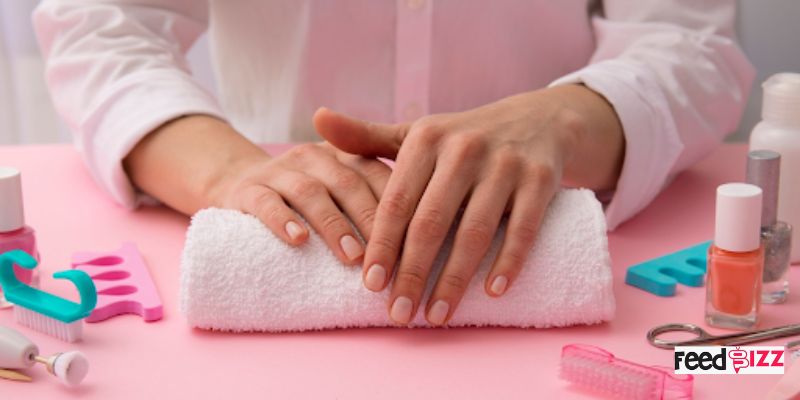Painting nails is easy and fun, and when done right, it enhances your look, boosting your self-esteem and confidence. But here’s the twist: the dreading removal process is something most nail enthusiasts share- they are a nightmare! Whether dealing with dark shades or glitter polishes, the paints cling to your nails stubbornly, and you could even damage them.
If you’ve tried but it didn’t go as you expected, you might be thinking of better ways to deal with this seemingly impossible task. Well, many ways to remove your nail polish without making a mess exist. Here, we will unravel some effective and practical nail polish removal techniques. So, if you are ready to bid goodbye to the chips, cracks, and damage and say hello to clean and healthy nails, let’s jump right in.
Determine the Type of Nail Polish You’re Wearing
There are different types of nail polishes, so pairing the removal with the right technique is essential for safe and effective removal.
- Traditional Nail Polish: It’s a widely used nail polish. Removing it is just as easy as its application since all you need is a cotton ball and some acetone-based remover.
- Gel Nail Polish: These are designed to last longer than normal nail polish. Curing it with UV light even makes it much stronger, which also makes it harder to remove. Avoid peeling or picking as it damages the nails, and use a more suitable technique, like filing, before applying Acetone.
- Dip Powder Nails: Like gel nails, dip powder polish should last longer. Removing them also requires more effort, including soaking for some time and applying a base remover like Acetone to break it down.
Top Nail Polish Removal Techniques
-
Using Acetone
Acetone hardly goes unmentioned when it comes to how to remove nails polish because it works magic on stubborn nail polish. It breaks down the nail polish quickly, making it easy to clean and remove without much effort. However, it must be used carefully to prevent drying on your nails and skin.
How to Use Acetone:
- Dip a cotton ball or pad in 100% acetone
- Wrap your fingers using plastic wrap and rub the cotton ball on your nails
- Give the Acetone around 10–15 minutes to take effect
- Using a soft cloth, rub off the polish gently
- Once the polish is removed, rinse with plenty of warm water
- Apply cuticle oil to hydrate your nails and skin
Pro Tip: If your skin reacts to Acetone, smear some petroleum jelly or cuticle oil around the edges of your nails and fingers before applying Acetone. It creates a barrier that stops the harshness from getting to your skin, causing drying.
-
Natural Alternatives to Acetone
If you don’t have access to Acetone or want to steer clear of Acetone, there are other gentler, natural ways to help with your nail polish removal. They include:
- Rubbing Alcohol: Pour a small amount of alcohol, like vodka, into a dish. Soaking your fingertips in alcohol is the solution to remove the nail polish by speeding up the breakdown.
- Lemon Juice and Vinegar: Combining lemon juice and white vinegar in equal amounts creates a natural polish remover. The high acidity caused by the lemon breaks down the polish while the vinegar strengthens the solution. After sitting for about 2 minutes, wipe it off.
- Hydrogen Peroxide: Hydrogen peroxide is not new to hacks. It helps with nail polish removal when mixed with warm water. Soak your nails, wait a few minutes, and wipe away the polish.
- Hairspray: Using aerosol hairspray, soak a cotton ball, wrap it on your nails, and let it sit for a few minutes. Use a cloth to gently wipe the polish and clean the nails.
- Toothpaste and Baking Soda: Apply a small amount of your normal toothpaste on the nail and sprinkle baking soda. After a few minutes, scrub the mixture gently until the nail polish loosens up before rinsing it with warm water.
- Orange Juice and Vinegar: Like lemon juice, orange juice is rich in citric acid that speeds up the breakdown while the vinegar strengthens it.
Post-Removal Care
The removal process of nail polish is the same; the base remover keeps changing in all these methods. But once it’s removed, whether using Acetone or non-acetone, it doesn’t stop there. Always moisturize using petroleum jelly, hand cream, or cuticle oil to restore moisture and keep your nails looking healthy. Additionally, drinking plenty of water also helps boost the skin’s and nails’ hydration from the inside.
Everything done? Don’t touch your nails for a couple of days. This break allows them to fully recover and strengthen before applying the following nail polish.
Conclusion
Without the right nail polish removal techniques, the process can be tough, often leaving you with damaged nails. But it doesn’t have to go down that way. With this guide, you now know some of the best techniques for nail polish removal.
Acetone is the widely used nail polish removal technique because of its effectiveness, but these other DIY techniques work, though not as well. Pick a favorite method and get the necessary supplies to get started. No longer struggle with stubborn nails but always practice care and maintenance after the removal to avoid hurting and keep your nails healthy.









